8
TRANSPORTATION AND TRADE
International Trade
Trade flows are one of many ways to illustrate interactions
between Canada and other countries. Comparing east-west interprovincial
trade flows with north-south international trade flows reveals
the increasing importance of outside markets to the provincial
economies.
From 1992 to 1998, international exports and imports grew at
an average annual rate of 11.9 per cent and 10.9 per cent,
respectively. Interprovincial trade, on the other hand, grew at
a more modest rate of 4.7 per cent. International exports and
imports almost doubled, with exports rising from $181 billion
to $356 billion, and imports jumping from $184 billion to $343
billion.
Figure 8-6 shows trends in interprovincial trade versus exports
and imports from 1992 to 1998.
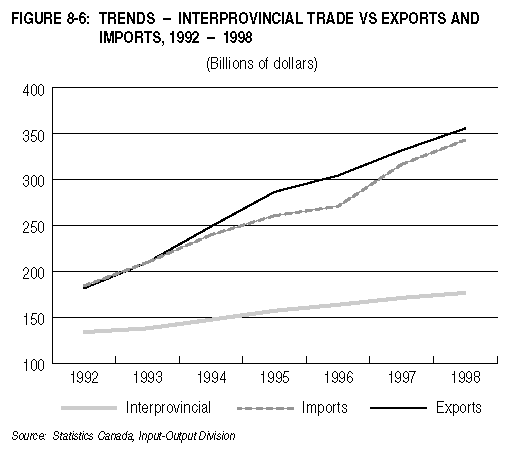
Composition of Imports and Exports
From 1992 to 1998, goods dominated international exports and
imports, with a share over services ranging from 82 to 84 per
cent. In 1998, goods traded by Canada at the international level
were estimated at $590 billion, while services were valued at
$110 billion.
Main services traded by provinces at the international level
were business and finance ($41 billion), transportation ($28 billion),
trade wholesaling ($13 billion), and personal/miscellaneous services
($13 billion). Goods were concentrated into manufactured products
and fabricated materials, totalling nearly 90 per cent of the total.
The share of primary goods fell from 11 to eight per cent
over this period.
Figure 8-7 shows Canada's external trade by type from 1992
to 1998.

Trade Flows and Modal Choice
To examine the relation between trade flows and the choice
of modes, the trade flows of goods will be explored in two ways:
Canada's trade with the US and Canada's trade with other countries.
Canada-US Trade
Impact of Canada-US Trade
Canada's trade with the US has been a driving force in the
overall performance of its economy and trade activities. From
1992 to 1998, the share of exports to the US rose from 77 to 85
per cent of Canada's total exports. At the same time, the share
of imports from the US increased from 65 to 68 per cent of Canada's
total imports from all countries.
From 1992 to 1998, exports to the US soared from $126 billion
to $270 billion, an annual growth rate of 13.6 per cent.
At 4.6 per cent, the average growth of exports to countries other
than the US was more modest, a situation partially explained
by the Asian and Latin American currency crises and a recession
that took a heavy toll on the economies in these regions during
1998.
Imports from the US grew by an average annual rate of 13.3
per cent, jumping from $96 billion to $204 billion. As for imports
from countries other than the US, the average growth rate reached
10.7 per cent.
Modal Split
Trucking and rail were the main modes of transportation for
transborder trade.Note 5 In 1998, the trucking mode
dominated Canada's trade with the US, at 63 per cent of exports
and 80 per cent of imports. This was followed by rail, at 21 per
cent of exports and nine per cent of imports. The pipeline mode
(included in "Other" mode) ranked third in carrying
exports to the US, while air took second place in imports.
From 1992 to 1998, the trucking and air modes registered a
slight increase in their shares (mainly in exports), while rail
and marine experienced a decline, both growing at a slower
pace than trucking and air.
Table 8-5 shows Canada's exports to and imports from the US
by mode and sector.
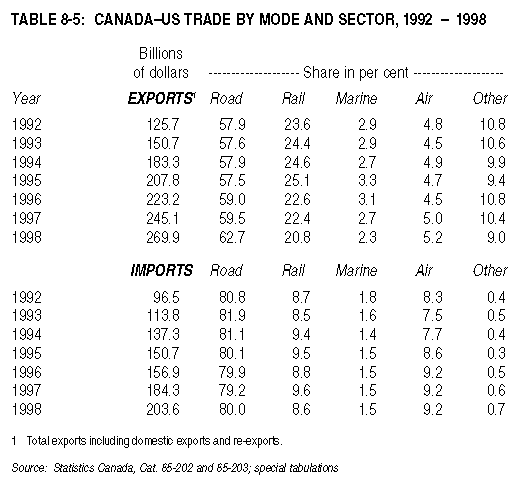
Canada-US Trade by Region
In 1998, four provinces captured 93 per cent of Canada's trade
with the US. Ontario dominated with 65 per cent of transborder
trade, accounting for $158 billion in exports and $148 billion
in imports. Quebec was next with 14 per cent, accounting
for $48 billion in exports and $20 billion in imports. Alberta
and British Columbia followed with seven per cent and six per
cent, respectively. All Canadian provinces, except Manitoba and
the Yukon Territory, registered a positive balance, as their exports
to the US exceeded their imports.
Table 8-6 shows Canada's trade with the US by province in 1988
and 1998. Provinces' shares did not vary significantly between
these two years.

In 1998, transborder trade by US regionNote 6 revealed the
predominance of the US Central region, which captured 43 per
cent of the trade for a total of $202 billion ($113 billion
from Canada, and $89 billion to Canada). The US North East
region ranked second with $107 billion (23 per cent of the trade),
followed by the US South at $94 billion and the US West at
$64 billion. All US regions recorded a negative balance with Canada,
except the South, which shipped more goods to Canada than it
received.
Figure 8-8 shows transborder trade by US region for 1988 and
1998.

Between 1988 and 1998, two US regions increased their shares
of trade with Canada: the South, from 16 per cent to 20 per cent,
and the West, from 11 per cent to 13 per cent. As explained later,
the increasing importance of US southern and western regions reflects
surface modes taking goods over longer distance, farther
away from Canadian points.
Preferred Mode
As mentioned previously, trucking is the dominant mode in Canada-US
trade. From 1991 to 1998, the number of trucks crossing Canada-US
border points increased at an average annual rate of 7.9 per cent,
from 19,680 units to 33,410 units on a daily basis.Note 7 Over the same
period, the share of daily crossings for trucks of Canadian firms
rose from 57 per cent to 66 per cent.
Canada-based for-hire trucking carriers have been transporting
goods over greater distances. From 1988 to 1998, the average distances
by tonne carried rose by an average annual rate of 2.7 per cent
for exports (from 791 to 1,037 kilometres) and by an average
rate of 2.5 per cent for importsNote 8 (from 928 to
1,184 kilometres).
Major Canada-US Trade Flows
In 1998, there were 16 two-way trade flows between Canada and
the US worth at least $9 billion each, representing close to 85
per cent of total Canada-US trade. Trucking was the dominant mode
of transportation, capturing a 50 per cent share or more in 14
of them.
Four trade flows, all involving Ontario, totalled $241 billion,
or more than 50 per cent of total transborder trade. The largest
was between Ontario and the US states bordering the Great Lakes,
which accounted for a 30 per cent share, with exports
of $75 billion and imports of $66 billion. The vehicles and parts
trade dominated Ontario's exports, mostly to Michigan, valued
at $44 billion ($39 billion carried by truck, $14 billion
by rail). Likewise, Ontario's imports consisted mainly of the
vehicle and parts trade at $26 billion ($22 billion by truck,
$4 billion by rail) and of machinery and equipment at $19 billion
with truck as the mode of choice.
Table 8-7 illustrates the 16 trade flows, showing the trade
balance and modal breakdown for each.
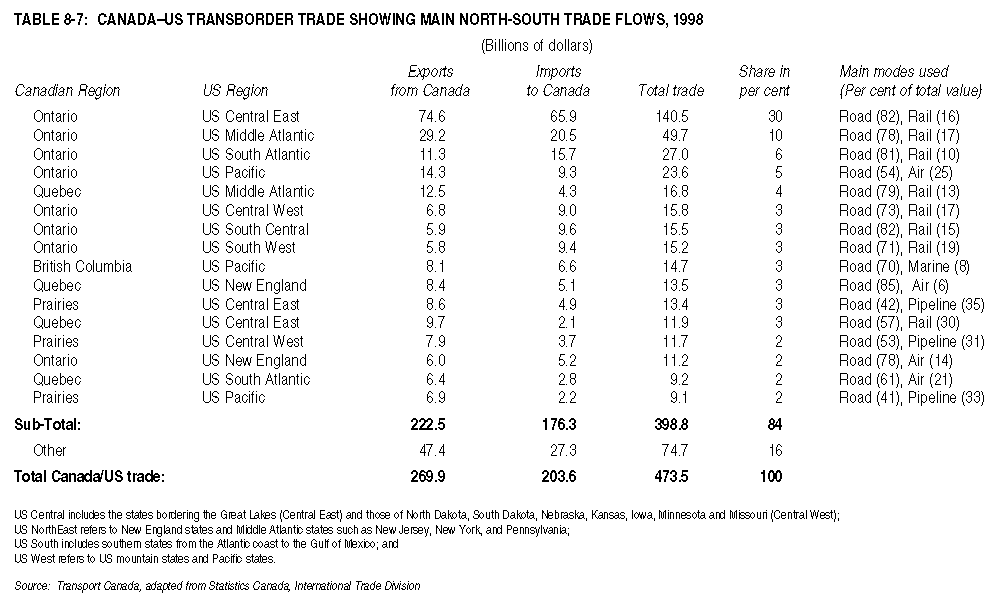
Figures 8-9 and 8-10 illustrate the Canada-US trade flows involving
Ontario and other Canadian regions.
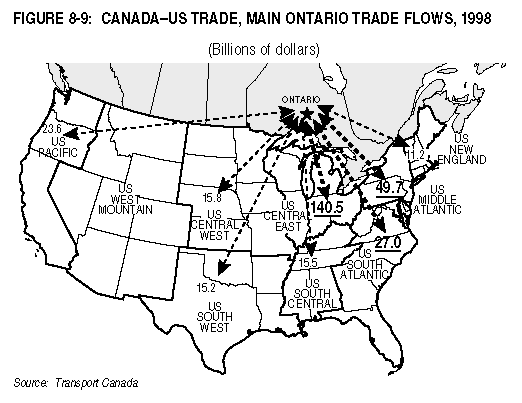

Strength of Canada-US Trade
Internal and external factors have contributed to the increase
in Canada's trade with the US. Among these are dollar exchange
rates and the gradual reduction of tariffs on goods as a result
of trade agreements.
From 1988 to 1998, the share of duties collected on total goods
imported from the US decreased steadily, from 2.6 per cent
to 0.2 per cent. Table 8-8 shows the share of duties collected
on selected imported goods from the US.

With exports, the currency exchange rate made Canadian goods
relatively less expensive to American consumers. Table 8-9 shows
the exchange rate evolution in recent years.

Canada's Trade with Countries Other than the US
Canada's trade with countries other than the US is less significant
than trade with the US. From 1992 to 1997, exports grew by an
average rate of 7.9 per cent, from $37 billion to $54 billion.
In 1998, however, they fell to $49 billion, due to recessions
and the financial crisis that hit the Asian and Latin American
economies. Imports from countries other than the US were
not affected by such financial crises and grew annually at
an average rate of 10.7 per cent, from $52 billion (1992)
to $95 billion (1998).
Figures 8-11 and 8-12 illustrate Canada's trade with countries
other than the US.


Trade by Mode
Marine and air were the primary modes used in trade with countries
other than the US. From 1992 to 1998, marine's share declined
in both exports and imports. Over the same period, air's share
grew from 16 to 19 per cent in exports, and from 15 to 22 per
cent in imports. This trend reflects the increasing trade in high-valued
commodities such as electronic and telecommunications equipment.
Air imports of electronic and electric machinery/equipment grew
at an average annual rate of 28 per cent, jumping from $1.2 billion
to $5.2 billion in value. The value of other equipment/machinery
imported by air also increased by an average 23 per cent over
the same period.
Table 8-10 shows modal shares of Canada's exports and imports
with countries other than the US.
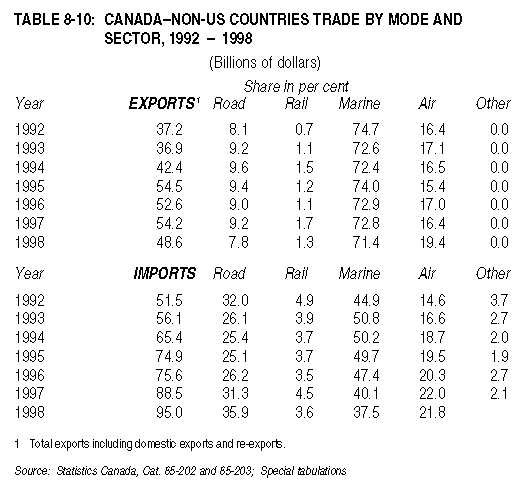
Direction of Trade Flows
Between 1988 and 1998, eastern and western provinces generally
shared exports to countries other than the US on an equal basis.
In 1998, however, eastern provinces accounted for a slightly larger
proportion (54 per cent) than western provinces. This reflects
decreased exports to the Pacific Rim countries, which were primarily
shipped from the western provinces.
In terms of the import of goods, the eastern provinces accounted
for over 80 per cent, dominated by Ontario, with 49 per cent.
From 1988 to 1998, the eastern provinces were the main provinces
of clearance for imports from countries other than the US, and
Ontario increased its share from 44 per cent to 49 per cent.
Canada had a negative trade balance with most countries other
than the US. In 1998, exports to overseas countries totalled $49
billion, while imports from the same countries reached $95 billion.
Figures 8-13 and 8-14 show provincial shares in Canada's trade
with countries other than the US in 1988 and 1998.


Major Trade Flows
In 1998, four trade flows accounted for 78 per cent of exports
to countries other than the US:
- eastern provinces to European countries: $14.3 billion
- western provinces to Pacific Rim countries: $13.1 billion
- eastern provinces to Pacific Rim countries: $5.7 billion
- western provinces to European countries: $4.7 billion.
Figures 8-15 and 8-16 illustrate Canada's main trade flow with
countries other than the US.
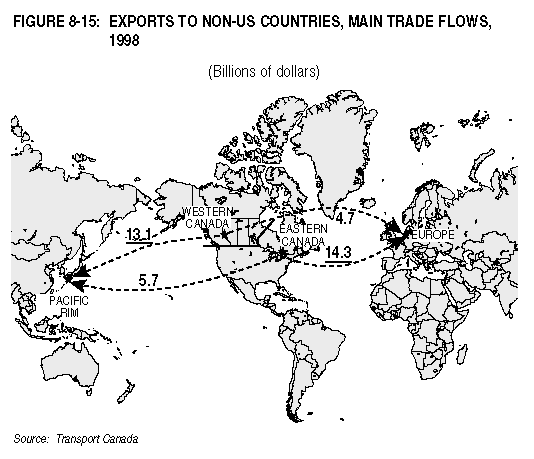
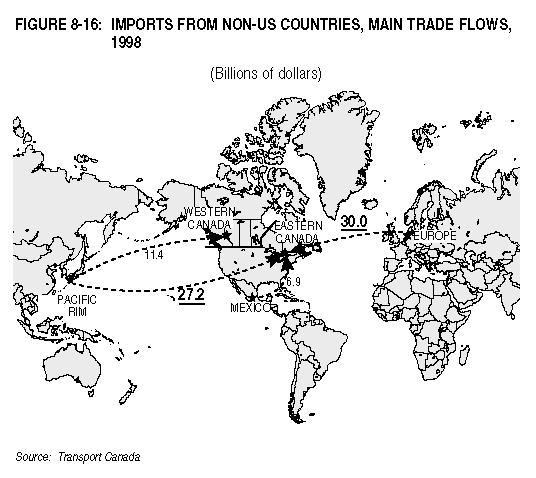
In terms of exports, the largest trade flow from the eastern
provinces to European countries totalled $14.3 billion. It
was composed primarily of electric/electronic machinery and other
equipment ($3.1 billion), non-ferrous products ($1.8 billion),
forest and paper products ($1.5 billion), and food products ($1 billion).
This trade was carried by water (60 per cent) and air (35 per
cent). The flow from the western provinces to the Pacific Rim
countries amounted to $13.1 billion. Forest and paper products,
food products and mineral fuels (e.g. coal) were the main traded
goods and were carried almost exclusively by water (96 per cent).
In 1998, four trade flows represented nearly 80 per cent of
goods imported from countries other than the US:
- European countries to the eastern provinces: $30.0 billion
- Pacific Rim countries to the eastern provinces: $27.2 billion
- Pacific Rim countries to the western provinces: $11.4 billion
- Mexico to the eastern provinces: $6.9 billion.
Imports to the eastern provinces from European countries represented
the largest trade flow with overseas countries, totalling $30
billion. The principal goods traded were electric/electronic machinery
and other equipment ($8.2 billion), chemical products ($3.6
billion), mineral fuels ($3.1 billion), motor vehicles and parts,
food, and steel products. The modes used were marine (47 per cent),
followed by air (30 per cent) and road (20 per cent).Note 9 In this case,
the road figure is probably overestimated, as part of it
covers transshipment via the US and the rest is distributed
on marine and air modes.
Imports to the western provinces from the Pacific Rim countries
totalled $27.2 billion in 1998, and included machinery and equipment
($6.8 billion), electric/electronic machinery ($6.5 billion),
steel products, motor vehicles and parts, and food processed
products. Goods were shipped by road (40 per cent), water (30
per cent) and air (24 per cent). As mentioned previously,
the road share is overestimated and would feed the marine and
air modes.Note
10
Tables 8-11 and 8-12 show the major trade flows between Canada
and countries other than the US.

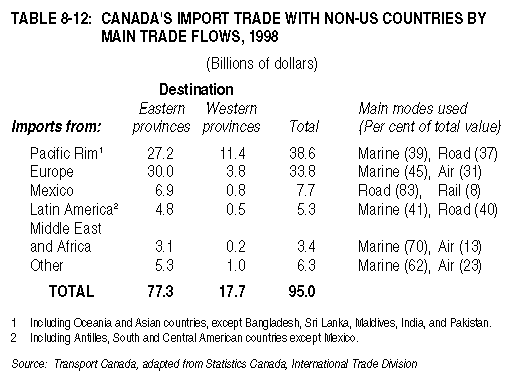
Duties on Imports
The influence of the General Agreement on Tariffs and Trade
(GATT) was felt on goods imported from countries other than the
US. From 1988 to 1998, the share of duties collected by Canada
Customs on these goods dropped from 5.7 per cent to 2.5 per cent.
Decreased duties paid on imported goods have been visible mainly
since 1992.
Table 8-13 reveals the share of duties collected on selected
imported goods from countries other than the US.

Recent Trends
World economy and trade have been affected in recent years
by financial crises and recessions that started in Japan and then
spread to neighbouring Asian countries and Latin America. Canadian
exports were significantly affected in 1998 as domestic exports
to Japan and Asian APECNote 11 (Asia-Pacific Economic Cooperation
group) countries declined by over 25 per cent from their 1997
levels.
In 1999, economies of Asian APEC countries did not fully recover
and remained sluggish. As a result, Canada's exports to Japan
and other APEC countries decreased by 3.5 and 5.4 per cent, respectively,
from 1998 levels. Canadian exports to other Latin American countries
fell by 20 per cent from 1998 to 1999.
Over the same time, domestic exports to the US increased by
over 14 per cent. By the end of 1999, Canada's exports to the
US accounted for 87 per cent of total Canadian exports, compared
with 81 per cent two years previously.
In 1999, imports to Canada from Japan and Asian APEC countries
were strong, with a combined growth rate of nine per cent
compared with that of 1998. This growth exceeded that of imports
from the US, which stood at 5.7 per cent for the same period.
Tables 8-14 and 8-15 reveal Canada's exports and imports by major
country grouping over the 1998-1999 period.


International Trade
NOTES
5
More than one mode of transportation might be used to carry traded
goods from origin to destination. For exports, the mode of transportation
indicates the mode by which the international boundary is crossed.
For imports, the mode of transportation represents the last mode
by which the cargo was transported to the port of clearance in
Canada. This may not be the mode by which the cargo arrived at
the Canadian port of entry in the case of inland clearance. This
may lead to some underestimation of Canadian imports by the marine
and air modes.
6
US regions include US Central, i.e. the states bordering the Great
Lakes (Central East) and those of North and South Dakota, Nebraska,
Kansas, Iowa, Minnesota and Missouri (Central West); US North
East, which refers to the New England and Atlantic states such
as New Jersey, New York and Pennsylvania; US South, which includes
southern states from the Atlantic coast to the Gulf of Mexico;
and US West, which includes US mountain and Pacific states.
7
Adapted by Transport Canada from Statistics Canada, International
Travel data.
8
Based on Statistics Canada, For-hire Trucking (Commodity Origin/Destination)
Survey.
9
Truck and rail information can be used to estimate the importance
of Canada's trade with countries other than the US, routed through
the US. With imports, however, such an estimate is more difficult
to determine, as cargo control documents information may lead
to some underestimation of Canadian imports by the marine and
air modes.
10
Please see notes 5 and 9.
11
At the end of 1999, the Asia-Pacific Economic Cooperation group
(APEC) had 21 members: besides Canada and the US, there were Australia,
New Zealand and Papua New Guinea; Chile, Peru and Mexico;
Brunei Darussalam, the People's Republic of China, Hong Kong,
Indonesia, Japan, South Korea, Malaysia, Philippines, Singapore,
Taiwan, Thailand, Vietnam and Russia.
|

